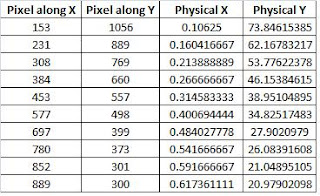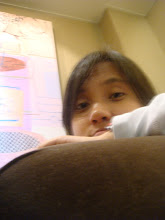Here are the steps that I used in reconstructing the graph:
1. Open the scanned graph using paint.
2. Obtain the pixel values of points in the graph by placing the pointer in the designated points.
3. The origin of the image and the reconstructed graph must coincide (the origin in an image is found at upper left corner of the image). This is done by getting the absolute value of the difference of the origin's pixel value and any other points' pixel values.
4. Tabulate the measured pixel values using Excel or OpenOffice Spreadsheet.
5. By using ratio and proportion, obtain the equation relating the physical values to the pixel values and use this to interpolate points on the graph.
6. Reconstruct the graph in Excel or Spreadsheet.
7. Compare the generated and the scanned graph by overlaying the two.
Here are the results obtained.
 The table above shows the pixel values (Pixel along X and Y) corresponding to the the physical values.
The table above shows the pixel values (Pixel along X and Y) corresponding to the the physical values. The figure above shows the scanned and the reconstructed graph. As one can observe there is an offset. Some points of the reconstruction are relatively far from its corresponding points on the scanned graph. This maybe because of the angled x-axis of the scanned image. I actually rotated the image in such a way that the y-axis would be vertical. However when I did that, it resulted to the angled x-axis. When I checked the hardcopy of the image, the x-axis of the graph is really tilted.
The figure above shows the scanned and the reconstructed graph. As one can observe there is an offset. Some points of the reconstruction are relatively far from its corresponding points on the scanned graph. This maybe because of the angled x-axis of the scanned image. I actually rotated the image in such a way that the y-axis would be vertical. However when I did that, it resulted to the angled x-axis. When I checked the hardcopy of the image, the x-axis of the graph is really tilted.For this activity, I will give myself a grade of 9. This is because I was able to reconstruct the graph similar to that of the original although there is a slight offset.
I thank Janno Vergara for teaching me how to overlay images on a spreadsheet graph and also the College of Science Library where the book X rays in Theory and Experiments can be found.





wow malas. bakit tilted yung scanned image kahit sa hardcopy?
ReplyDeleteIt seems this graph got distorted on its way to getting digitized,maybe during photocopying. If the journal is bound with other journals in a book mahirap syang i-flatten sa xerox machine.
ReplyDelete